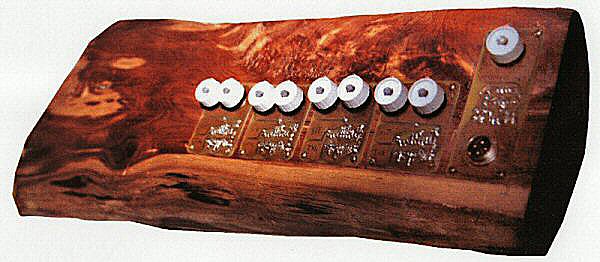Please wait a few moments while we process your request

Peter Blasser
shinths
The artist's approach is part of a current trend called circuit bending, or the community of circuit benders. Before explaining the neologism shinth that Blasser coined, you need to place his practice within the context of this movement.
Circuit Bending: modification of circuits; twist, inflect; curve, fold, warp, distort. In short, the artistic transformation of electronic children's toys into musical instruments. Also, the connecting (forcing?) of various points of electronic circuits in ways that were not meant to be, so as to modify the existing sounds and create unexpected effects.
Origin: the term circuit bending was first used in the late 60s by the pioneer Reed Ghazala. It referred to the art of taking an ordinary electronic instrument, such as the Texas Instruments Speak&Spell, and redistributing its circuits to produce a device that can create all kinds of bizarre sounds. Originally developed as educational toys for pre-school children, these machines made use of the first commercial form of voice synthesis, which made them ideal for circuit bending. Their circuits are so simple that it is easy to create all manner of feedback loops and "sound glitches" like you have never heard before…
In 1967, Ghazala accidentally created the first "bend" instrument; a broke teenage musician and visual artist, he sought to explore unconventional realities during a time marked by rampant experimentalism. Ironically. his instruments can now be found in the permanent collections of some of the most prestigious museums: the Museum of Modern Art (New York), the Guggenheim Museum (New York), the Whitney Museum of American Art (New York) and several private collections around the world. (1)
Inventing unusual music is one thing; modifying objects intended for commercial use, and hence protected by law, and bending them is quite another. Circuit benders staunchly uphold this subversive attitude as an anticapitalist gesture. Their activities speak for themselves: circuit benders rummage through secondhand shops and find their potential prey or target in the form of old toys, and common objects such as obsolete computer pieces, etc. Ultimately, they recuperate, recycle and invent with junk.
This way of working is paradoxical: to compose music with toys that were clearly not developed for this purpose. In fact, the singularity of this approach resides precisely in that contradiction. But as eccentric as this approach may be, there are certain affinities with various 20th century artistic movements. Without creating a lineage, it would be interesting, and even pertinent to highlight the crucial importance of détournement in modern and contemporary art. Détournement has been fruitfully put to use by, among others, Duchamp, Fluxus, the New Realists, the process art of the 60s and 70s and numerous artists during the 70s and 80s who appropriated already existing images from the mass media. Closer to us, you could also presume that there is a sympathetic bond between circuit benders, hackers and open source advocates. Finally, we shouldn’t forget the influence of circuit benders in the industrial, techno and ambient music scenes. In fact, many musicians use Ghazala's "bend" instruments in recording studios or during concerts.
"The shinth does nothing. I want to make it." Peter Blasser
As for Peter Blasser's work, the project that the foundation is supporting consists of two parts: to develop a series of electronic instruments likely to interest circuit benders, and to organize a traveling exhibit where circuit benders will have the opportunity to experiment with these instruments.
The shinth is a neologism coined by the artist to describe an electronic device that neither indicates nor provides any mechanical control of its process. The shinth is a musical instrument stripped of its exterior, its protective envelope, thus revealing the circuit board. Rather than pressing on keys or twisting knobs, the user produces sounds by directly touching the circuits. For Blasser, the important thing is to expose the interior surface of bare circuits. Form and content are made equal here. Clearly, circuit benders question the pertinence of the exterior envelope of commercial electronic instruments, which supposedly serve to protect the user from an electric shock. According to Blasser, the only possible danger with the shinths is not to receive a shock, but to saturate sensitive areas of the instrument with an electric current that is too powerful.
In expanding on his thoughts, the artist further remarks that acoustic music is faced with the same situation. The violinist touches the strings of his or her instrument to produce sounds. The strings of a violin and printed circuit boards are analogous in that both are visible and exterior. He convincingly argues that the violinist is therefore, in his or her way, also a bender!
Blasser insists that all his shinths be "bent" by performers, hence the pertinence of the exhibition-performance format. In November and December 2003, accompanied by Fashion Flesh and Twig Harper, the artist-curator crisscrossed the United States presenting performances in various venues (galleries, cafés, art centers). Intuitive and requiring no instruction, the shinths are accessible to anyone who wishes to explore their sonic potential. After the performance the spectators were invited to give free reign to their imagination by manipulating these singular objects. In a section of his website, Blasser recounts certain moments of the tour and one can hear and see not only Blasser and his musicians, but also spectators - suddenly transformed into performers - playing the shinths. (2) As an extension of this project, Blasser has also conceived and created other sonic instruments. (3)
Circuit Bending: modification of circuits; twist, inflect; curve, fold, warp, distort. In short, the artistic transformation of electronic children's toys into musical instruments. Also, the connecting (forcing?) of various points of electronic circuits in ways that were not meant to be, so as to modify the existing sounds and create unexpected effects.
Origin: the term circuit bending was first used in the late 60s by the pioneer Reed Ghazala. It referred to the art of taking an ordinary electronic instrument, such as the Texas Instruments Speak&Spell, and redistributing its circuits to produce a device that can create all kinds of bizarre sounds. Originally developed as educational toys for pre-school children, these machines made use of the first commercial form of voice synthesis, which made them ideal for circuit bending. Their circuits are so simple that it is easy to create all manner of feedback loops and "sound glitches" like you have never heard before…
In 1967, Ghazala accidentally created the first "bend" instrument; a broke teenage musician and visual artist, he sought to explore unconventional realities during a time marked by rampant experimentalism. Ironically. his instruments can now be found in the permanent collections of some of the most prestigious museums: the Museum of Modern Art (New York), the Guggenheim Museum (New York), the Whitney Museum of American Art (New York) and several private collections around the world. (1)
Inventing unusual music is one thing; modifying objects intended for commercial use, and hence protected by law, and bending them is quite another. Circuit benders staunchly uphold this subversive attitude as an anticapitalist gesture. Their activities speak for themselves: circuit benders rummage through secondhand shops and find their potential prey or target in the form of old toys, and common objects such as obsolete computer pieces, etc. Ultimately, they recuperate, recycle and invent with junk.
This way of working is paradoxical: to compose music with toys that were clearly not developed for this purpose. In fact, the singularity of this approach resides precisely in that contradiction. But as eccentric as this approach may be, there are certain affinities with various 20th century artistic movements. Without creating a lineage, it would be interesting, and even pertinent to highlight the crucial importance of détournement in modern and contemporary art. Détournement has been fruitfully put to use by, among others, Duchamp, Fluxus, the New Realists, the process art of the 60s and 70s and numerous artists during the 70s and 80s who appropriated already existing images from the mass media. Closer to us, you could also presume that there is a sympathetic bond between circuit benders, hackers and open source advocates. Finally, we shouldn’t forget the influence of circuit benders in the industrial, techno and ambient music scenes. In fact, many musicians use Ghazala's "bend" instruments in recording studios or during concerts.
"The shinth does nothing. I want to make it." Peter Blasser
As for Peter Blasser's work, the project that the foundation is supporting consists of two parts: to develop a series of electronic instruments likely to interest circuit benders, and to organize a traveling exhibit where circuit benders will have the opportunity to experiment with these instruments.
The shinth is a neologism coined by the artist to describe an electronic device that neither indicates nor provides any mechanical control of its process. The shinth is a musical instrument stripped of its exterior, its protective envelope, thus revealing the circuit board. Rather than pressing on keys or twisting knobs, the user produces sounds by directly touching the circuits. For Blasser, the important thing is to expose the interior surface of bare circuits. Form and content are made equal here. Clearly, circuit benders question the pertinence of the exterior envelope of commercial electronic instruments, which supposedly serve to protect the user from an electric shock. According to Blasser, the only possible danger with the shinths is not to receive a shock, but to saturate sensitive areas of the instrument with an electric current that is too powerful.
In expanding on his thoughts, the artist further remarks that acoustic music is faced with the same situation. The violinist touches the strings of his or her instrument to produce sounds. The strings of a violin and printed circuit boards are analogous in that both are visible and exterior. He convincingly argues that the violinist is therefore, in his or her way, also a bender!
Blasser insists that all his shinths be "bent" by performers, hence the pertinence of the exhibition-performance format. In November and December 2003, accompanied by Fashion Flesh and Twig Harper, the artist-curator crisscrossed the United States presenting performances in various venues (galleries, cafés, art centers). Intuitive and requiring no instruction, the shinths are accessible to anyone who wishes to explore their sonic potential. After the performance the spectators were invited to give free reign to their imagination by manipulating these singular objects. In a section of his website, Blasser recounts certain moments of the tour and one can hear and see not only Blasser and his musicians, but also spectators - suddenly transformed into performers - playing the shinths. (2) As an extension of this project, Blasser has also conceived and created other sonic instruments. (3)
Jacques Perron © 2003 FDL
(1) For more on Reed Ghazala, see http://www.anti-theory.com/bio/
Related page:
 Peter Blasser
Peter BlasserPeter Blasser has definitly followed a very singular path: a degree in Electronic Music and Chinese, with minors in Computer Science and Ancient Greek.
External links:
Peter Blasser:
http://www.ciat-lonbarde.net
http://www.ciat-lonbarde.net








